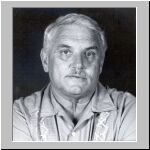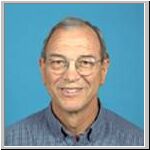THE
HISTORY AND ACHIEVEMENTS OF THE NEMATOLOGY SECTION, 1955-2002
Florida
Department of Agriculture
by
R. P. ESSER
and P. S LEHMAN


ORIGINS
Informal phase
Seventy-eight years ago, on
February 21, 1917, Plant Inspectors Luther Brown and Dillard Grimes detected
cyst nematodes in a shipment of figs going from Argyle, Florida to Pensacola.
This nematode detection was possibly the first of its kind by a regulatory
organization in Florida, and plant inspectors have been on guard against
these pests ever since. From 1919 to 1954, plant inspectors submitted 1,102
samples for nematode detection. In this early period, bulb and stem, cyst,
foliar, root-knot and lesion nematodes were the chief nematode pests targeted
by the inspectors.
Formal Phase
Dr. Benjamin
G. Chitwood, one of the world's most eminent nematologists, joined
the State Plant Board in February 1955. Dr. Chitwood established a Department
of Nematology and served as its first chief. Dr. Chitwood initiated methodology,
systems, and procedures essential to the operation of a proper nematological
installation, many of which survive today. He also completely equipped
the new Department, and taught the fundamentals of Nematology to Dr. Chancellor
I. Hannon, who was employed in May 1955, to Robert
P. Esser, who transferred from Plant Inspection to the Department of
Nematology in July 1955, and to Dr. Leon G. van Weerdt who was employed
in February 1956. Dr. Wray Birchfield
joined the State Plant Board in June 1954, and came under the jurisdiction
of the Department of Nematology in 1955. Dr. Birchfield conducted principally
burrowing nematode research at Winter Haven, Florida. He also supervised
the burrowing nematode identification laboratory in Lake Alfred. Dr. Dewey
Raski, on sabbatical leave from the University of California, was employed
by the State Plant Board in October 1955 and worked for six months on burrowing
nematode control.
Dr. Chitwood resigned in
January 1958 and Dr. Birchfield in June 1959. Fred Donaldson joined the
Nematology Department in 1959 and served as a nematologist until 1966.
Dr. van Weerdt was appointed chief and served until 1960, at which time
he resigned to enter law school. R. P. Esser was in charge of the Nematology
Department and then Nematology Section from 1960 through 1968. In January
1961 the Florida Department of Agriculture absorbed the duties and staff
of the State Plant Board. In the reorganization, the Department of Nematology
became the Nematology Section. John B. MacGowan joined the Department of
Plant Inspection in July 1960. He was placed in charge of a mobile Nematology
Laboratory in Apopka, Florida. The objective of this unit was to survey
and process nursery samples for reniform nematode. He became a member of
the Nematology Section in 1964.
Donald E. Stokes transferred
from Plant Inspection to the Nematology Section in February 1966. Dr. Kenneth
R. Langdon assumed the position of Botanist, in addition to his regular
duties as a nematologist. Dr. Langdon was Nematologist-In-Charge from 1968
to 1972. In 1969 the Nematology Section became the Bureau of Nematology.
In November 1972, the position of chief, vacant since 1960, was filled
with the appointment of Alfred
L. Taylor, formerly in charge of the Nematology Investigations within
the Agricultural Research Service of the United States Department of Agriculture.
A. L Taylor served as chief until December 1975. Dr. D. E. Stokes was appointed
Chief Nematologist in January 1976 and served until his retirement in October
1982. During Dr. Stokes tenure, Dr. James G. Baldwin (June 1976 until June
1978) and Dr. Paul S. Lehman
(August 1978 to present) joined the staff. Dr. R. P. Esser served as nematologist-in-charge
from November 1982 until July 1984, when Dr. John
H. O'Bannon assumed the duties of chief. Dr. Renato
N. Inserra joined the Bureau in 1985. Following Dr. O'Bannon's resignation
in September 1991, Connie Riherd (Assistant Director) assumed the duties
of acting chief until December1992 when the three technical bureaus were
amalgamated into the Bureau of Entomology, Nematology, and Plant Pathology,
and designated as individual sections within the Bureau. At that time,
Dr. Wayne N. Dixon
was appointed Chief, Bureau of Entomology, Nematology, and Plant Pathology
and he has served also as Biological Administrator for the Nematology Section
since that time. Dr. R. P Esser retired in 1999 and was replaced by Dr.
Claudia Riegel in January 2000. She resigned a few months later to accept
a position with industry and Dr. Janete A. Brito joined the Nematology
Section in October 2000.
SUMMARY OF THE NEMATOLOGY
SECTION’S PROGRAMS AND ACTIVITIES
Current activities of this section are analyses of soil and plant samples for nematodes, identification of plant parasitic nematodes involved in regulatory and certification programs, pest detection surveys, and diagnosis of plant problems. State of Florida Statutes and regulatory rules applicable to nematode pests mandate the principal part of the regulatory activity of the Section. Nematological analyses include those from in-state programs, out-of-state and out-of-country plant shipments originating in Florida, and shipments intercepted in Florida from outside the United States. Other functions focus on surveys to detect exotic nematode pests, describing new nematode species, maintenance of taxonomic data retrieval systems, nursery sanitation programs, host testing, biological control investigations, and molecular diagnostic research.
BENEFITS FROM THE NEMATOLOGY SECTION’S PROGRAMS
The Nematology
Section was established in the mid-1950s because the burrowing nematode
began causing serious decline of citrus in Central Florida. The Florida
Department of Agriculture, in cooperation with citrus growers, launched
regulatory programs to prevent the spread of this serious nematode pest
of citrus. Also at this time a parallel program to tract the burrowing
nematode of Citrus was established by the United States Department of Agriculture
in Winter Haven, Florida. Later this Program was turned over to the Florida
Department of Agriculture and Consumer Services, with S. Simpson and J.
Ward in charge of nematode sample analyses in the Winter Haven laboratory
until the Nematology Section in Gainesville assumed this responsibility
in 1984.A very conservative estimate
is that these regulatory programs prevented the spread of the burrowing
nematode into 44,000 acres or 18,000 hectares. The benefits of these burrowing
nematode regulatory programs for Florida’s citrus growers from 1960 to1994
are calculated to be 1.4 billion dollars. The regulatory management costs
were only about 7% of the benefits to the growers, or for every $70,000
invested in the programs there was a return of $1million.
Citrus nursery
certification programs insure that seedlings produced in citrus nurseries
are free of burrowing nematodes and other nematode pests. For the past
35 years these programs have been very effective in preventing the spread
of nematode pests into Florida's citrus groves. Because citrus is a perennial
crop which may be productive for 25 to 40 years, growers benefit for many
years from planting certified seedlings. For the 2000 crop season alone,
the benefit to growers from excluding nematodes from their groves through
planting certified nematode-free seedlings was calculated to be 50 million
dollars in on-tree value of fruit. Total annual costs to the Plant Inspection
and Nematology section for nematode certification programs for citrus nurseries
was $75,000 in 2000. Thus, in 2000 for every dollar invested in the administration
of the nematode certification program in Florida, there was a return of
approximately $666 to growers.
Florida's ornamental industry also greatly benefits from the activities of the Nematology Section. Nematode certification programs for ornamental plants allow the ornamental industry of Florida to export plants to markets located in other states and countries that impose restrictions against nematode pests occurring in Florida. Without these certification programs many export markets would be closed to Florida's billion-dollar ornamental industry.
In addition, the Nematology Section's programs benefit the general public. Sanitation and certification programs that exclude nematodes lower pesticide use, thus impacting favorably on the environment. These programs prevent the spread of nematodes that damage crops, lower production costs for growers and, in the end, result in lower food costs. It is also recognized that a strong vibrant economy in Florida is linked to the agricultural industry, especially healthy citrus and ornamental sectors.
The
Nematology Section has been the major contributor to our knowledge of nematode
distribution and biodiversity in Florida. Since 1955, the Nematology Section
has analyzed over 600,000 nematode samples.At
least 372 plant parasitic nematode species have been reported in Florida
based on DPI records and original taxonomic descriptions of nematodes from
Florida. One subfamily, three genera and 20 species have been originally
described in the Nematology Section.
Taxon Authors and year
Haliplectus bickneri Chitwood, 1956
Meloidodera floridensis Chitwood, Hannon & Esser,
1956
Criconema decalineatum Chitwood, 1957
Criconema spinalineatum Chitwood, 1957
Xiphinemella esseri Chitwood, 1957
Hemicriconemoides biformis Chitwood & Birchfield,
1957
Hemicriconemoides floridensis Chitwood & Birchfield,
1957
Hemicriconemoides wessoni Chitwood & Birchfield,
1957
Hemicriconemoides chitwoodi Esser, 1960
Hemicriconemoides minutus Esser, 1960
Hemicriconemoides strictathecatus Esser,
1960
Sphaeronema whittoni Sledge & Christie, 1962
Hypsoperine graminis Sledge & Golden, 1964
Xiphinema macrostylum Esser, 1981
Verutinae
Esser, 1981
Verutus volvingentis Esser, 1981
Meloidogyne cruciani Garcia-Martinez, Taylor & Smart,
1982
Tylenchulus graminis Inserra, Vovlas, O'Bannon & Esser,
1988
Tylenchulus palustris Inserra, Vovlas, O'Bannon &
Esser, 1988
Mesocriconema ornicauda Vovlas, Inserra & Esser, 1991
Ogma floridense Vovlas, Inserra & Esser, 1991
Updated JANUARY 2011
This document was constructed
and is maintained by KHUONG
B. NGUYEN
Entomology
and Nematology Department
University of Florida